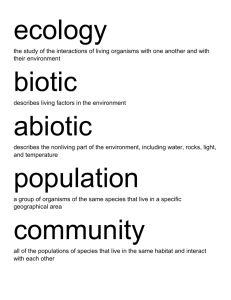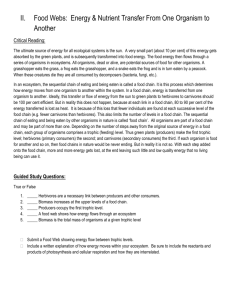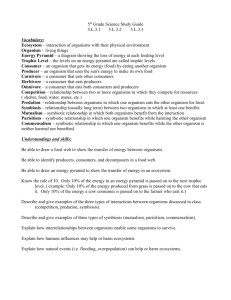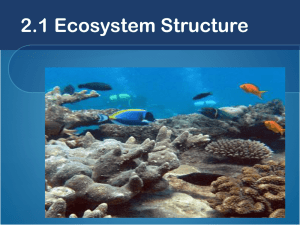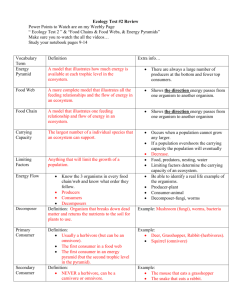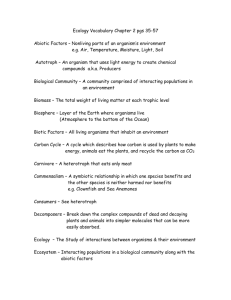ECOLOGY REVIEW SHEET
advertisement
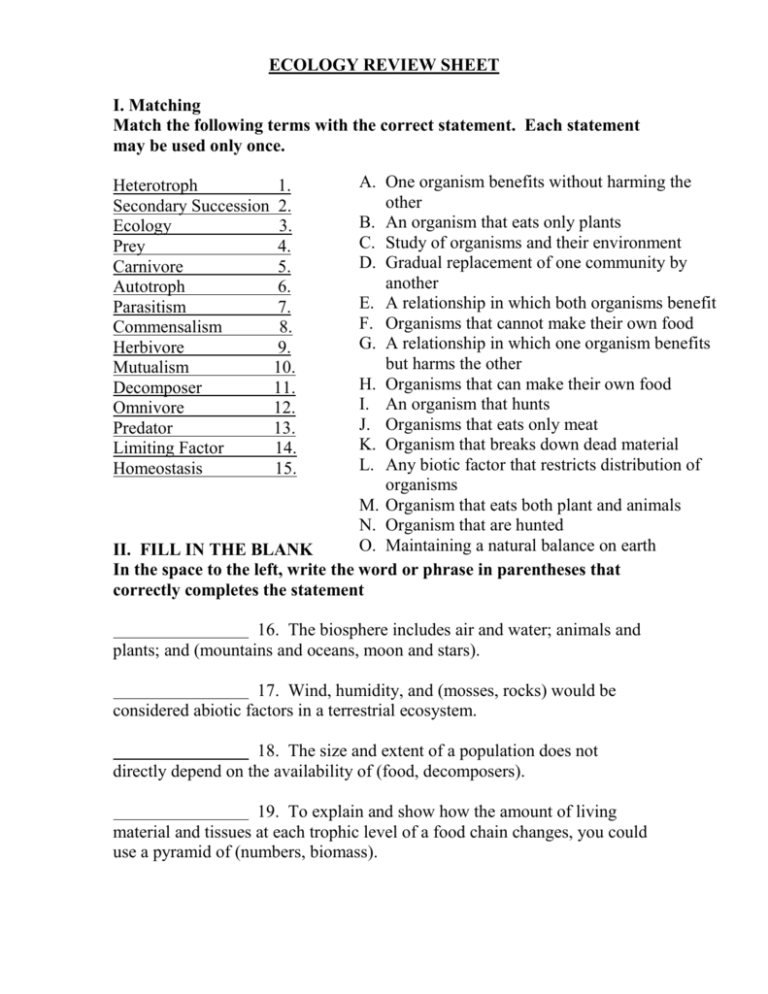
ECOLOGY REVIEW SHEET I. Matching Match the following terms with the correct statement. Each statement may be used only once. A. One organism benefits without harming the other B. An organism that eats only plants C. Study of organisms and their environment D. Gradual replacement of one community by another E. A relationship in which both organisms benefit F. Organisms that cannot make their own food G. A relationship in which one organism benefits but harms the other H. Organisms that can make their own food I. An organism that hunts J. Organisms that eats only meat K. Organism that breaks down dead material L. Any biotic factor that restricts distribution of organisms M. Organism that eats both plant and animals N. Organism that are hunted O. Maintaining a natural balance on earth II. FILL IN THE BLANK P. In the space to the left, write the word or phrase in parentheses that correctly completes the statement Heterotroph 1. Secondary Succession 2. Ecology 3. Prey 4. Carnivore 5. Autotroph 6. Parasitism 7. Commensalism 8. Herbivore 9. Mutualism 10. Decomposer 11. Omnivore 12. Predator 13. Limiting Factor 14. Homeostasis 15. 16. The biosphere includes air and water; animals and plants; and (mountains and oceans, moon and stars). 17. Wind, humidity, and (mosses, rocks) would be considered abiotic factors in a terrestrial ecosystem. 18. The size and extent of a population does not directly depend on the availability of (food, decomposers). 19. To explain and show how the amount of living material and tissues at each trophic level of a food chain changes, you could use a pyramid of (numbers, biomass). 20. In the nitrogen cycle, (bacteria and lightning, decomposers) convert atmospheric nitrogen into nitrogen compounds usable by plants. 21. Energy that passes through a food chain is lost to the environment as (heat, matter). 22. Water, carbon, and nitrogen are released back into the atmosphere during (symbiosis, decomposition). 23. Both the algae and the fungus are benefited from their relationship in a lichen. This is one of (mutualism, commensalism). 24. In a pond ecosystem, ducks, mosquitoes, pond plants, and frogs are (abiotic, biotic) factors. In the space to the left, write the word or phrase that includes the rest. 25. trophic level, food web, food chain 26. parasitism, commensalism, mutualism, symbiosis 27. organism, ecosystem, population, community 28. ecosystems, biotic factors, biosphere, abiotic factors 29. omnivores, consumers, carnivores, herbivores 30. evaporation, precipitation, water cycle, respiration 31. little rainfall, plants with waxy coats, desert, tundra 32. low temp., little precipitation, tundra, permafrost Use the following diagram to answer questions 30-35. Grass Caterpillar Bird Mouse Snake Grasshopper Frog Owl 33. What is the producer in the food web above? 34. Energy flows from the mouse to the ___________ and ___________ 35. The primary consumers are _________, ___________, ___________. 36. The secondary consumers are ______, ______, ________, and ____. 37.The owl is a secondary consumer if it eats the _________, but a tertiary (third order) consumer if it eats the _________, ________, or ______. 38.As matter and energy move from grasses to owl, the amount of available energy always (increases, decreases) but the population size may increase or decrease. 39.Define biomass: 40. Fill-in the four levels of the energy pyramid diagram below with the following information: the trophic level, the niche of the organism that occupies each trophic level, and the amount of energy available at each trophic level. 41.Based on the energy pyramid diagram above, the greatest amount of energy (and biomass) in a healthy ecosystem will be found in the _______________________. 42.Based on the energy pyramid diagram above, there is about 100X more energy stored in Trophic Level A than in __________. For questions 43-46, Use the legend below E= Exponential Growth L= Logistic Growth 43. This type of growth tends to level off upon the carrying capacity. 44. This type of growth has a period of steady growth. 45. This type of growth is more realistic and true 46. This type of growth keeps growing forever if unchecked III. SHORT ANSWER 47. Explain what the carrying capacity is in a logistic growth curve. 48. List the 6 levels of biological organization from general to specific. 49. Explain the difference between a niche and habitat. Niche: Habitat: 50. List 3 types of symbiotic relationships and give examples of each. 1. example: 2. example: 3. example: 51. Compare and contrast a food chain and a food web. Food Chain: Food Web: 52. Explain how Eubacteria and Fungi are important in cycling of nutrients in the environment. 53. What is the difference between a limiting factor and carrying capacity? 54. Compare and contrast primary and secondary succession. Primary: Secondary: 55. What is the first thing to appear AFTER a natural disaster, such as a forest fire, has devastated an ecosystem? 56. Compare and contrast density- dependent and density independent factors. Density- dependent: Density- independent: 57. What is the main cause of ozone depletion? 58. What is the main cause of the greenhouse effect? 59. Carbonic acid, sulfur released from factories, and nitric acid released from cars combine with water to produce 60. Human activity, variations in climate, and the melting of polar ice caps may possibility contribute to 61. Contrast immigration and emigration. Which one causes the size of a population to increase ? 62.If all of the mosquito larvae are removed from the food web above, which populations will decrease? 63. If the ecosystem above was contaminated with DDT, a harmful chemical, which population would contain the highest concentration of DDT? 64. The image above is a population graph from a predator/prey game. The line with the highest peaks indicates rabbits, the line with moderate peaks represents grass, and the lowest line indicates wolves. What appears to have happened to the wolf population? What factor seems to be controlling the rabbit population? 65. The image above is a population graph from a predator/prey game. The highest line (on the right-side of graph) indicates grass, the line that reaches 50% (on day 56) represents rabbits, and the lowest line indicates wolves. What does the rapid growth in grass shown on the right-side of the graph probably indicate?



